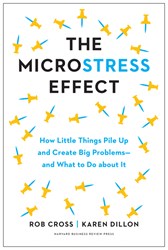The Microstress Effect: How Little Things Pile Up and Create Big Problems—And What to Do about It
April 13, 2023
The Microstress Effect is a great read for anyone, but especially for the person who wants to understand where their mental energy is going and how best to rebuild and protect it.
The Microstress Effect: How Little Things Pile Up and Create Big Problems—and What to Do about It by Rob Cross and Karen Dillon, Harvard Business Review Press
Porchlight’s Managing Director, Sally Haldorson, recently interviewed Andre Sólo, co-author of the book Sensitive: The Hidden Power of the Highly Sensitive Person in a Loud, Fast, Too-Much World. Early in the interview, the two discussed the idea of limited mental energy as posited in 1903 by sociologist Georg Simmel, which contends that people have a finite capacity to process sensory information—and that our mental energy is drained by every stimulus and action, big and small, that we encounter throughout our day. That capacity is different for everyone. Sally referenced an analogy from the book about variously sized buckets, with highly sensitive people, who process information at a deeper level, holding buckets that fill more quickly than the buckets of people with average to low sensitivity.
But what exactly is filling those mental buckets on a daily basis? Books such as Burnout by Emily and Amelia Nagoski, Laziness Does Not Exist by Devon Price, and Overwhelmed by Brigid Schulte have done an excellent job highlighting the broad systemic issues that keep us mentally fatigued, such as precarious economic conditions, toxic work environments, and racial and gender inequity. But there is an often-undetected layer of forces adding to our chronic overwhelm, which Rob Cross and Karen Dillon uncover in their new book, The Microstress Effect.
Cross and Dillon define microstress as “tiny moments of stress triggered by people in our personal and professional lives; stresses so routine that we barely register them but whose cumulative toll is debilitating.” Whereas the threat of a layoff or a hostile coworker would count as major workplace stressors, microstress encompasses smaller, everyday incidents like a change in project priorities or an endless pinging of emails and Slack messages interrupting one’s workflow. These events don’t necessarily trigger the same fight-or-flight response that a major stressor would, but they still slow us down over time.
Our world has become deeply interconnected through our digital devices. On one hand, this means we can stay in touch easily with friends and loved ones and access novel ideas and information from around the world. On the other hand, it means there’s an endless stream of information and stimulus right at our fingertips and a growing societal expectation that being constantly online is the same as being constantly available to others. In such a world where the lines between home and work are forever blurred, Cross and Dillon argue that our accumulation of microstress at work ripples into our home lives and vice versa. Left unchecked, microstress can wear down our mental focus to a debilitating degree.
Through the first half of the book, Cross and Dillon divide sources of microstress into three broad categories. First, there are microstresses that drain our personal capacity, such as dealing with an unpredictable authority figure or experiencing a surge in work responsibilities. Then, there are microstresses that take an emotional toll, which can stem from confrontational conversations or experiencing a lack of trust within our teams. Finally, there are the microstresses that challenge our identity, such as making life choices that run counter to our personal values or suffering from undermined confidence.
Not everyone experiences every kind of microstress, but of the fourteen examples Cross and Dillon offer, there is no doubt some combination that any reader will find themselves identifying with. While describing the microstress of secondhand stress, Cross and Dillon note:
Merely observing someone who is stressed—especially a coworker or family member—can have an immediate effect on our own nervous systems. One group of researchers found that 26 percent of people showed elevated levels of cortisol just by observing someone who was stressed. Worse yet, technology lets us broadcast our aggressive voice or constant questions to many people all at once.
I consider myself a highly sensitive person, which means I’m already inherently prone to absorbing the emotions of people around me whether I want to or not. Understanding that stress can be contagious helped me understand why there can be days when I feel exhausted for no obvious reason—it could be someone else’s stress, whether overheard or read about, that I’m incorporating into my own. Cross and Dillon note that making this distinction and taking intentional steps to decompress—such as taking a walk, doing a breathing exercise, or any other calming activity—can help diminish the cumulative effects of microstress and bring back mental clarity.
The latter half of the book offers solutions to pushing back on microstress. The overarching solution, according to Cross and Dillon, lies in our ability to connect meaningfully with other people. This means developing dimensions in our life beyond just work and home, such as finding hobbies where we can engage with others over our shared interests, reaching out to friends we haven’t seen in a while, or making time to get to know our neighbors better. When our lives are multidimensional, we create space for our microstresses to dissipate, as we are no longer defined solely by our work. Cross and Dillon write:
Resilience is found not just in having people to lean on when times get tough, but in the interactions themselves—the conversations that validate our plans, reframe our perspective, help us laugh and feel authentic with others, or just encourage us to get back up and try again. Resilience is essential to coping with microstress. Bouncing back from any individual microstress helps avoid a pileup of microstresses that drag you down.
Though sensitivity varies from person to person, what we all have in common is that we live in a world that is increasingly sensitizing, bombarding us with constant updates, information, and stimuli. We may think we’re used to it all—perhaps even de-sensitized to it—yet our rising rates of burnout indicate otherwise. For the sake of our mental health, it’s worth it to pause and make sure we’re giving ourselves the best shot at a balanced life. The Microstress Effect is a great read for anyone, but especially for the person who wants to understand where their mental energy is going and how best to rebuild and protect it. After reading this book, I feel better equipped to understand the underlying and accumulating causes of stress we all encounter and to move towards creating a more resilient and healthy life for myself and for others.




